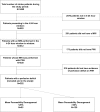Blood-brain barrier integrity of stroke patients presenting in an extended time window
- PMID: 32054451
- PMCID: PMC7017520
- DOI: 10.1186/s12883-020-01634-2
Blood-brain barrier integrity of stroke patients presenting in an extended time window
Abstract
Background: Current guidelines limit thrombolytic treatment of stroke to those patients who present within 4.5 h to minimize the risk of hemorrhagic complications. Risk of hemorrhage increases with increasing blood-brain barrier (BBB) disruption. This study aimed to determine, in a cohort of patients presenting outside of an IV-tPA treatment window, whether disruption of the BBB is time dependent, and what proportion of patients could be safely treated.
Methods: We analyzed untreated stroke patients, seen between 2011 and 2015, who had MRI studies in the time window of 4 to 24 h from symptoms onset. Permeability of the BBB was measured within the ischemic tissue using an application of dynamic susceptibility contrast imaging. Patients were dichotomized into two groups based on a 20% threshold of BBB disruption and compared using logistic regression.
Results: Of the 222 patients included in the final analysis, over half, 129 (58%), had preserved BBB integrity below the 20% threshold. There was no relationship between time imaged after symptom onset and the amount of BBB disruption (p = 0.138) across the population; BBB disruption varied widely.
Conclusions: Estimating BBB integrity may help to expand the treatment window for stroke patients by identifying those individuals for whom thrombolytic therapy can be considered.
Keywords: Blood-brain barrier; Extended time window; Permeability imaging; Stroke; Thrombolysis.
Conflict of interest statement
The authors declare that they have no competing interests.
Figures




References
-
- The National Institute of Neurological Disorders and Stroke rt-PA Stroke Study Group Tissue plasminogen activator for acute ischemic stroke. N.Engl.J.Med. 1995;333(24):1581–1587. - PubMed
-
- Hacke W, et al. Thrombolysis with alteplase 3 to 4.5 hours after acute ischemic stroke. N.Engl.J.Med. 2008;359(13):1317–1329. - PubMed
-
- Powers WJ, et al. 2018 guidelines for the early Management of Patients with Acute Ischemic Stroke: a guideline for healthcare professionals from the American Heart Association/American Stroke Association. Stroke. 2018;49(3):e46–e110. - PubMed
-
- Demaerschalk BM, et al. Scientific rationale for the inclusion and exclusion criteria for intravenous Alteplase in acute ischemic stroke: a statement for healthcare professionals from the American Heart Association/American Stroke Association. Stroke. 2016;47(2):581–641. - PubMed
-
- Intracerebral hemorrhage after intravenous t-PA therapy for ischemic stroke. The NINDS t-PA stroke study group. Stroke, 1997. 28(11): p. 2109–18. https://www.ncbi.nlm.nih.gov/pubmed/9368550. - PubMed
MeSH terms
Substances
Grants and funding
LinkOut - more resources
Full Text Sources
Medical

